2001 BMW 540I SEDAN light
[x] Cancel search: lightPage 11 of 238
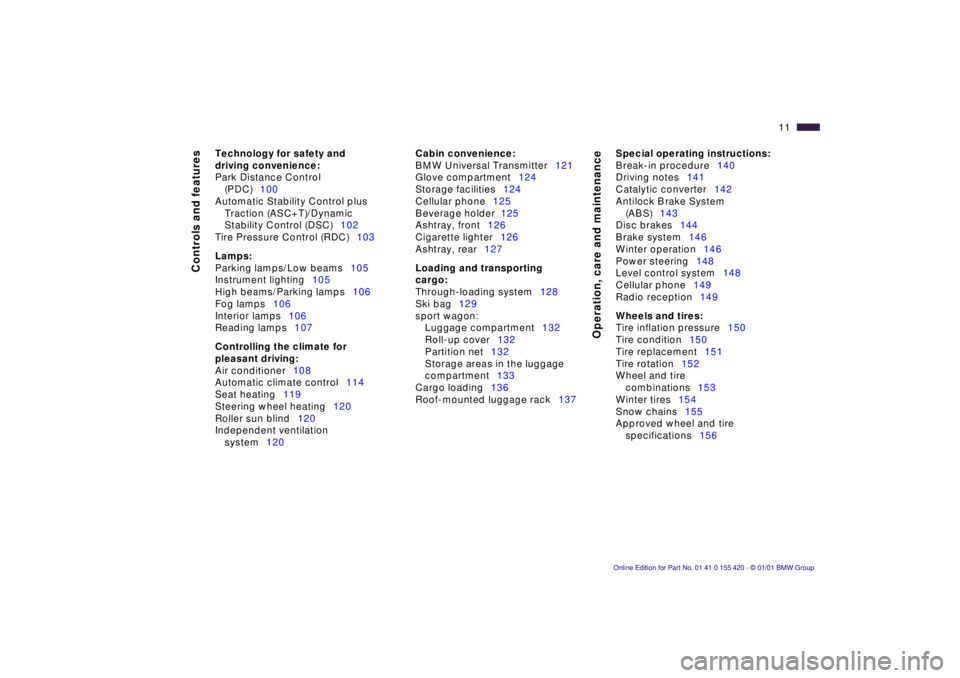
11n
Controls and features
Operation, care and maintenance
Technology for safety and
driving convenience:
Park Distance Control
(PDC)100
Automatic Stability Control plus
Traction (ASC+T)/Dynamic
Stability Control (DSC)102
Tire Pressure Control (RDC)103
Lamps:
Parking lamps/Low beams105
Instrument lighting105
High beams/Parking lamps106
Fog lamps106
Interior lamps106
Reading lamps107
Controlling the climate for
pleasant driving:
Air conditioner108
Automatic climate control114
Seat heating119
Steering wheel heating120
Roller sun blind120
Independent ventilation
system120
Cabin convenience:
BMW Universal Transmitter121
Glove compartment124
Storage facilities124
Cellular phone125
Beverage holder 125
Ashtray, front126
Cigarette lighter126
Ashtray, rear127
Loading and transporting
cargo:
Through-loading system128
Ski bag129
sport wagon:
Luggage compartment132
Roll-up cover132
Partition net132
Storage areas in the luggage
compartment133
Cargo loading136
Roof-mounted luggage rack137
Special operating instructions:
Break-in procedure140
Driving notes141
Catalytic converter142
Antilock Brake System
(ABS)143
Disc brakes144
Brake system146
Winter operation146
Power steering148
Level control system148
Cellular phone149
Radio reception149
Wheels and tires:
Tire inflation pressure150
Tire condition150
Tire replacement151
Tire rotation152
Wheel and tire
combinations153
Winter tires154
Snow chains155
Approved wheel and tire
specifications156
Page 22 of 238

22n
Indicator and warning lampsTechnology that monitors itselfMany of the systems of your BMW
monitor themselves automatically, both
during engine starts and while you are
driving. Indicator and warning lamps
that are identified by "l" are tested for
proper functioning whenever the igni-
tion key is turned. They each light up
once for different periods of time.
If a fault should occur in one of these
systems, the corresponding lamp does
not go out after the engine is started or
it lights up while the vehicle is moving.
You will see how to react to this below.
Red: stop immediately
Battery charge current l
The battery is no longer being
charged. There is a malfunction
of the alternator V-belt or in the charg-
ing circuit of the alternator. Please con-
tact the nearest BMW center.
If the ribbed V-belt is defective, do
not continue driving. The engine
could be damaged due to overheating.
If the ribbed V-belt is defective, in-
creased steering effort is also re-
quired.<
Engine oil pressure l
Comes on while the engine is
running and the "STOP!ENGINE
OILPRESS" message appears in the
Check Control: stop vehicle immedi-
ately and switch off engine. Check level
of oil in engine, top up as required. If oil
level is correct: please contact the
nearest BMW center.
Do not continue driving. The en-
gine could be damaged because
of inadequate lubrication.<
Tire Pressure Control (RDC)
* l
In addition, there is an acousti-
cal warning signal: a tire failure
has occurred. Reduce vehicle speed
immediately and stop the vehicle. Avoid
hard brake applications. Do not over-
steer. For additional information: refer
to page 103.
Parking brake
*,
brake hydraulic system l
Comes on when you engage the
parking brake. For additional informa-
tion: refer to page 70.
Comes on although the parking brake is
released: have the brake fluid level
checked. Before driving further, be
sure to read the notes on pages 146
and 168.
Also comes on with the message
"CHECK BRAKE PADS" in the Check
Control.
Parking brake* warning lamp/
Brake hydraulic system for
Canadian models.
Page 24 of 238
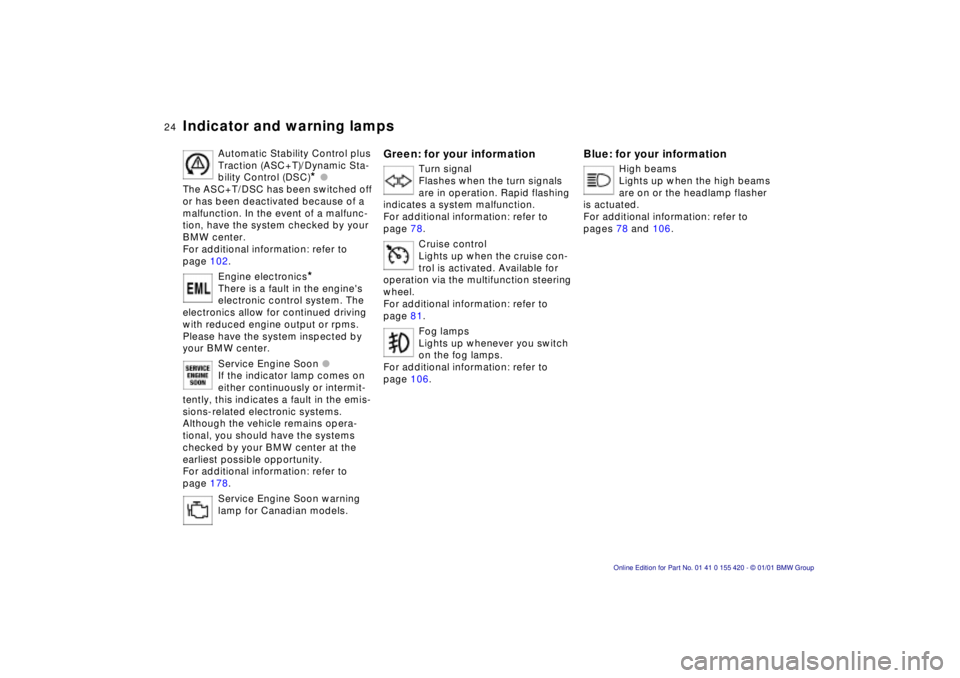
24n
Indicator and warning lamps
Automatic Stability Control plus
Traction (ASC+T)/Dynamic Sta-
bility Control (DSC)
* l
The ASC+T/DSC has been switched off
or has been deactivated because of a
malfunction. In the event of a malfunc-
tion, have the system checked by your
BMW center.
For additional information: refer to
page 102.
Engine electronics
*
There is a fault in the engine's
electronic control system. The
electronics allow for continued driving
with reduced engine output or rpms.
Please have the system inspected by
your BMW center.
Service Engine Soon l
If the indicator lamp comes on
either continuously or intermit-
tently, this indicates a fault in the emis-
sions-related electronic systems.
Although the vehicle remains opera-
tional, you should have the systems
checked by your BMW center at the
earliest possible opportunity.
For additional information: refer to
page 178.
Service Engine Soon warning
lamp for Canadian models.
Green: for your information
Turn signal
Flashes when the turn signals
are in operation. Rapid flashing
indicates a system malfunction.
For additional information: refer to
page 78.
Cruise control
Lights up when the cruise con-
trol is activated. Available for
operation via the multifunction steering
wheel.
For additional information: refer to
page 81.
Fog lamps
Lights up whenever you switch
on the fog lamps.
For additional information: refer to
page 106.
Blue: for your information
High beams
Lights up when the high beams
are on or the headlamp flasher
is actuated.
For additional information: refer to
pages 78 and 106.
Page 35 of 238
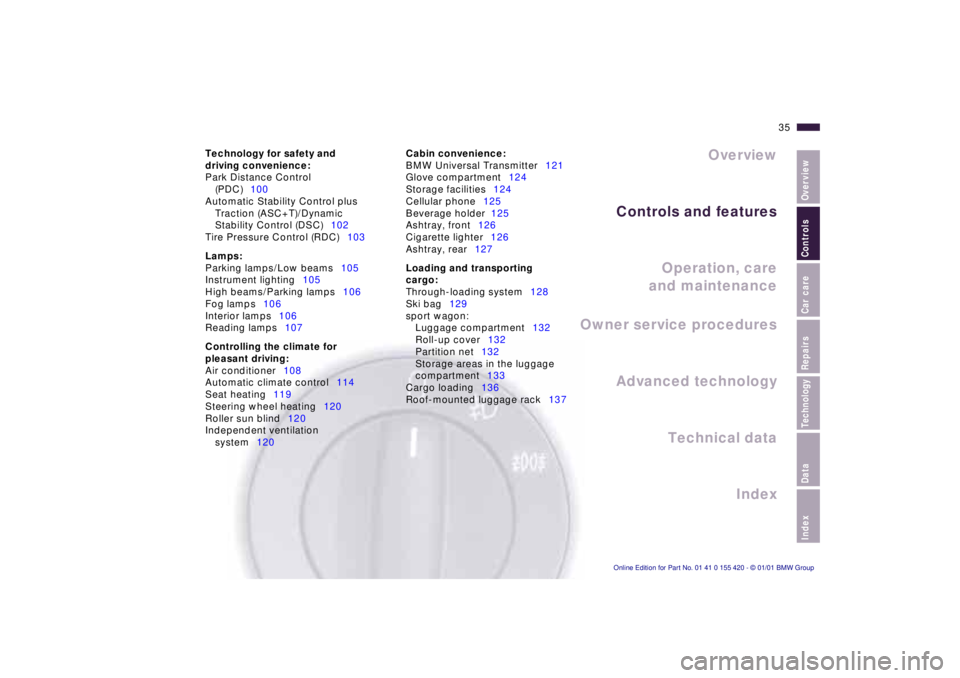
IndexDataTechnologyRepairsCar careControlsOverview
Overview
Controls and features
Operation, care
and maintenance
Owner service procedures
Technical data
Index Advanced technology
35n
Technology for safety and
driving convenience:
Park Distance Control
(PDC)100
Automatic Stability Control plus
Traction (ASC+T)/Dynamic
Stability Control (DSC)102
Tire Pressure Control (RDC)103
Lamps:
Parking lamps/Low beams105
Instrument lighting105
High beams/Parking lamps106
Fog lamps106
Interior lamps106
Reading lamps107
Controlling the climate for
pleasant driving:
Air conditioner108
Automatic climate control114
Seat heating119
Steering wheel heating120
Roller sun blind120
Independent ventilation
system120Cabin convenience:
BMW Universal Transmitter121
Glove compartment124
Storage facilities124
Cellular phone125
Beverage holder 125
Ashtray, front126
Cigarette lighter126
Ashtray, rear127
Loading and transporting
cargo:
Through-loading system128
Ski bag129
sport wagon:
Luggage compartment132
Roll-up cover132
Partition net132
Storage areas in the luggage
compartment133
Cargo loading136
Roof-mounted luggage rack137
Page 39 of 238
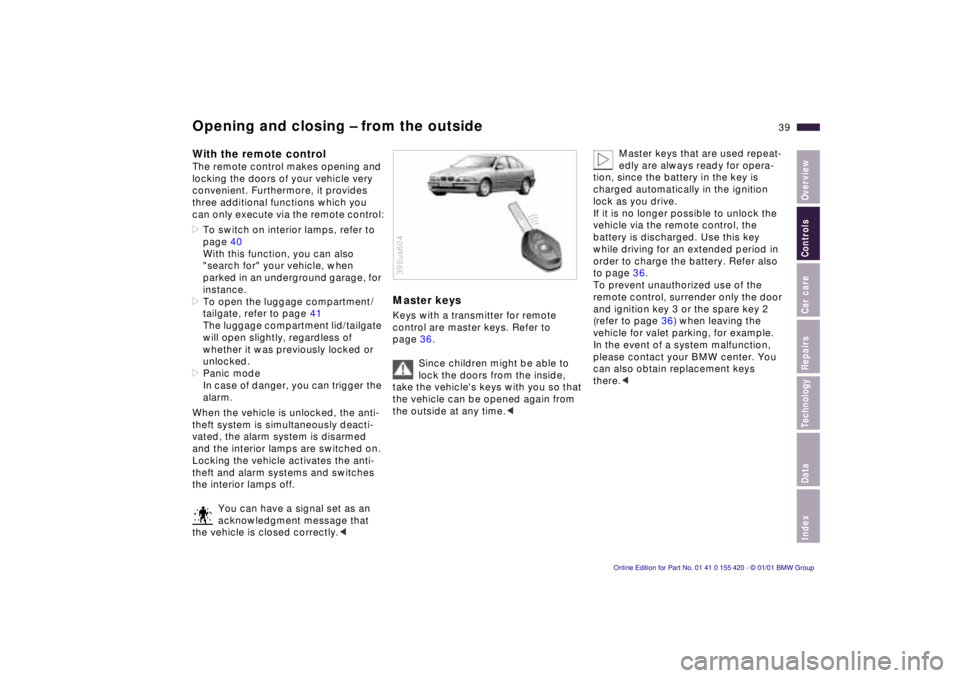
IndexDataTechnologyRepairsCar careControlsOverview
39n
Opening and closing – from the outsideWith the remote controlThe remote control makes opening and
locking the doors of your vehicle very
convenient. Furthermore, it provides
three additional functions which you
can only execute via the remote control:
>To switch on interior lamps, refer to
page 40
With this function, you can also
"search for" your vehicle, when
parked in an underground garage, for
instance.
>To open the luggage compartment/
tailgate, refer to page 41
The luggage compartment lid/tailgate
will open slightly, regardless of
whether it was previously locked or
unlocked.
>Panic mode
In case of danger, you can trigger the
alarm.
When the vehicle is unlocked, the anti-
theft system is simultaneously deacti-
vated, the alarm system is disarmed
and the interior lamps are switched on.
Locking the vehicle activates the anti-
theft and alarm systems and switches
the interior lamps off.
You can have a signal set as an
acknowledgment message that
the vehicle is closed correctly.<
Master keysKeys with a transmitter for remote
control are master keys. Refer to
page 36.
Since children might be able to
lock the doors from the inside,
take the vehicle's keys with you so that
the vehicle can be opened again from
the outside at any time.< 390us604
Master keys that are used repeat-
edly are always ready for opera-
tion, since the battery in the key is
charged automatically in the ignition
lock as you drive.
If it is no longer possible to unlock the
vehicle via the remote control, the
battery is discharged. Use this key
while driving for an extended period in
order to charge the battery. Refer also
to page 36.
To prevent unauthorized use of the
remote control, surrender only the door
and ignition key 3 or the spare key 2
(refer to page 36) when leaving the
vehicle for valet parking, for example.
In the event of a system malfunction,
please contact your BMW center. You
can also obtain replacement keys
there.<
Page 41 of 238
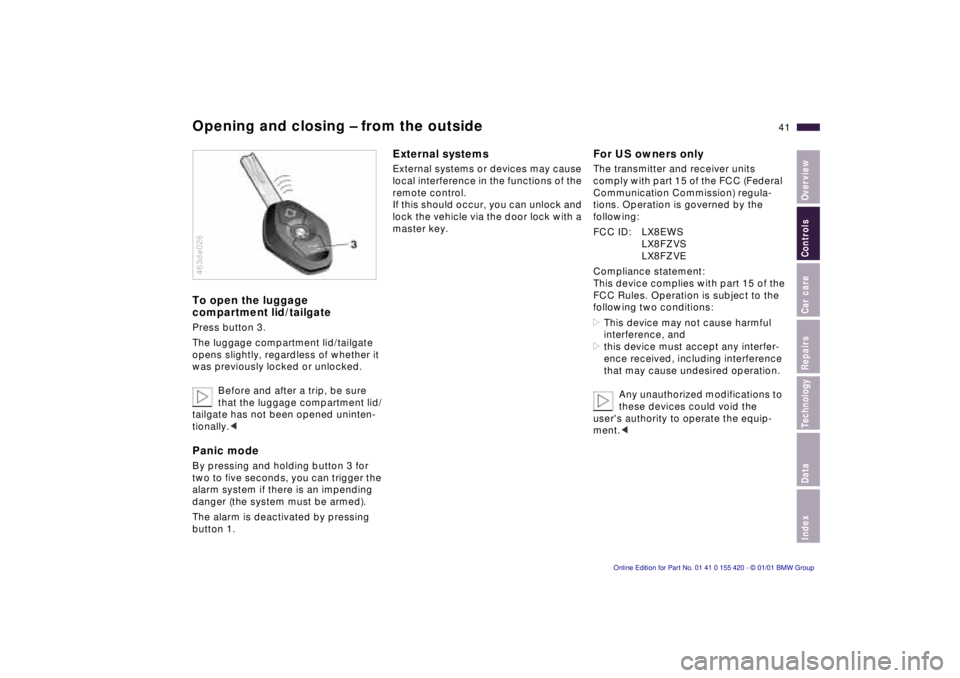
IndexDataTechnologyRepairsCar careControlsOverview
41n
Opening and closing – from the outsideTo open the luggage
compartment lid/tailgatePress button 3.
The luggage compartment lid/tailgate
opens slightly, regardless of whether it
was previously locked or unlocked.
Before and after a trip, be sure
that the luggage compartment lid/
tailgate has not been opened uninten-
tionally.< Panic modeBy pressing and holding button 3 for
two to five seconds, you can trigger the
alarm system if there is an impending
danger (the system must be armed).
The alarm is deactivated by pressing
button 1.463de026
External systemsExternal systems or devices may cause
local interference in the functions of the
remote control.
If this should occur, you can unlock and
lock the vehicle via the door lock with a
master key.
For US owners onlyThe transmitter and receiver units
comply with part 15 of the FCC (Federal
Communication Commission) regula-
tions. Operation is governed by the
following:
FCC ID: LX8EWS
LX8FZVS
LX8FZVE
Compliance statement:
This device complies with part 15 of the
FCC Rules. Operation is subject to the
following two conditions:
>This device may not cause harmful
interference, and
>this device must accept any interfer-
ence received, including interference
that may cause undesired operation.
Any unauthorized modifications to
these devices could void the
user's authority to operate the equip-
ment.<
Page 43 of 238
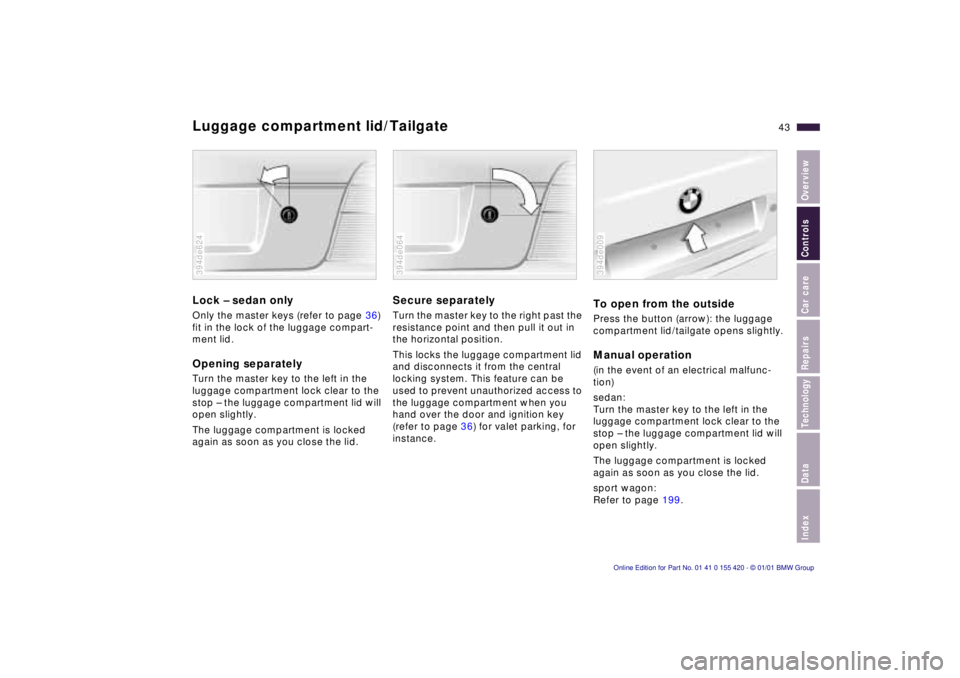
IndexDataTechnologyRepairsCar careControlsOverview
43n
Luggage compartment lid/TailgateLock – sedan onlyOnly the master keys (refer to page 36)
fit in the lock of the luggage compart-
ment lid.Opening separatelyTurn the master key to the left in the
luggage compartment lock clear to the
stop – the luggage compartment lid will
open slightly.
The luggage compartment is locked
again as soon as you close the lid.394de624
Secure separatelyTurn the master key to the right past the
resistance point and then pull it out in
the horizontal position.
This locks the luggage compartment lid
and disconnects it from the central
locking system. This feature can be
used to prevent unauthorized access to
the luggage compartment when you
hand over the door and ignition key
(refer to page 36) for valet parking, for
instance.394de064
To open from the outsidePress the button (arrow): the luggage
compartment lid/tailgate opens slightly.Manual operation(in the event of an electrical malfunc-
tion)
sedan:
Turn the master key to the left in the
luggage compartment lock clear to the
stop – the luggage compartment lid will
open slightly.
The luggage compartment is locked
again as soon as you close the lid.
sport wagon:
Refer to page 199.394de009
Page 44 of 238
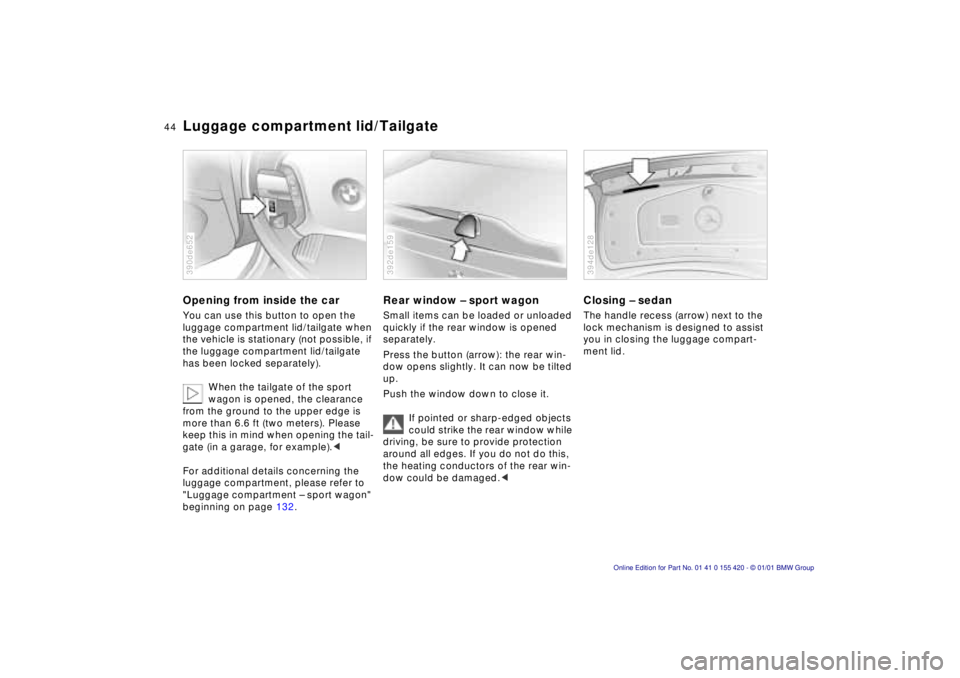
44n
Luggage compartment lid/TailgateOpening from inside the carYou can use this button to open the
luggage compartment lid/tailgate when
the vehicle is stationary (not possible, if
the luggage compartment lid/tailgate
has been locked separately).
When the tailgate of the sport
wagon is opened, the clearance
from the ground to the upper edge is
more than 6.6 ft (two meters). Please
keep this in mind when opening the tail-
gate (in a garage, for example).<
For additional details concerning the
luggage compartment, please refer to
"Luggage compartment – sport wagon"
beginning on page 132.390de652
Rear window – sport wagonSmall items can be loaded or unloaded
quickly if the rear window is opened
separately.
Press the button (arrow): the rear win-
dow opens slightly. It can now be tilted
up.
Push the window down to close it.
If pointed or sharp-edged objects
could strike the rear window while
driving, be sure to provide protection
around all edges. If you do not do this,
the heating conductors of the rear win-
dow could be damaged.< 392de159
Closing – sedanThe handle recess (arrow) next to the
lock mechanism is designed to assist
you in closing the luggage compart-
ment lid.394de128